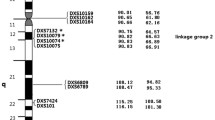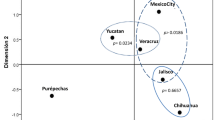Abstract
Polymorphic genetic markers located on the X chromosome might become a complement in particular forensic identification when the biological kinship are deficient. We analyzed forensic statistical parameters of 33 X-chromosome InDel polymorphisms in a sample of 320 individuals from Argentina. The X-chromosome InDel polymorphism (X-InDel) panel was amplified in a single multiplex PCR reaction. Hardy-Weinberg Equilibrium was determined in the female cohort, whereas the male cohort was used to calculate linkage disequilibrium (LD) tested by an extension of Fisher’s exact test, D’, and Chi-square values. Regarding LD, 15 markers were organized and grouped into six blocks containing two or three linked loci each, namely block I (MID356-MID357), block II (MID448804-MID3703-MID218), block III (MID3705-MID3706-MID304737), block IV (MID197147-MID3754), block V (MID3664-MID284601-MID103547), and block VI (MID3763-MID3728). The haplotype diversity was higher than 0.99 in all cases. Blocks III and VI showed the highest match probability in the studied population, whereas block II showed the lowest. The accumulated power of discrimination was 99.9999991 % in women and 99.9992925 % in men. The mean exclusion chance in trios and duos were 99.9891736 and 99.6099391 %, respectively. Since 15 markers are associated as haplotypic blocks, for a conservative treatment of the data, statistical evaluation should consider their haplotypic frequencies and the remaining 18 markers can be evaluated as independent loci.
Similar content being viewed by others
References
Chakraborty R, Stivers DN, Su B, Zhong Y, Budowle B (1999) The utility of short tandem repeat loci beyond human identification: implications for development of new DNA typing systems. Electrophoresis 20(8):1682–1696
Butler JM (2011) In: Advanced topics in Forensic DNA typing: methodology. 3er Edition. edn., pp 324–328
Jobling MA, Tyler-Smith C (2003) The human Y chromosome: an evolutionary marker comes of age. Nat Rev Genet 4(8):598–612
Roewer L, Krawczak M, Willuweit S, Nagy M, Alves C, Amorim A, Anslinger K, Augustin C, Betz A, Bosch E, Caglia A, Carracedo A, Corach D, Dekairelle AF, Dobosz T, Dupuy BM, Furedi S, Gehrig C, Gusmao L, Henke J, Henke L, Hidding M, Hohoff C, Hoste B, Jobling MA, Kargel HJ, de Knijff P, Lessig R, Liebeherr E, Lorente M, Martinez-Jarreta B, Nievas P, Nowak M, Parson W, Pascali VL, Penacino G, Ploski R, Rolf B, Sala A, Schmidt U, Schmitt C, Schneider PM, Szibor R, Teifel-Greding J, Kayser M (2001) Online reference database of European Y-chromosomal short tandem repeat (STR) haplotypes. Forensic Sci Int 118(2–3):106–113
Szibor R, Hering S, Kuhlisch E, Plate I, Demberger S, Krawczak M, Edelmann J (2005) Haplotyping of STR cluster DXS6801-DXS6809-DXS6789 on Xq21 provides a powerful tool for kinship testing. Int J Legal Med 119(6):363–369
Gusmao L, Sanchez-Diz P, Alves C, Gomes I, Zarrabeitia MT, Abovich M, Atmetlla I, Bobillo C, Bravo L, Builes J, Caine L, Calvo R, Carvalho E, Carvalho M, Cicarelli R, Catelli L, Corach D, Espinoza M, Garcia O, Malaghini M, Martins J, Pinheiro F, Joao Porto M, Raimondi E, Riancho JA, Rodriguez A, Rodriguez A, Rodriguez Cardozo B, Schneider V, Silva S, Tavares C, Toscanini U, Vullo C, Whittle M, Yurrebaso I, Carracedo A, Amorim A (2009) A GEP-ISFG collaborative study on the optimization of an X-STR decaplex: data on 15 Iberian and Latin American populations. Int J Legal Med 123(3):227–234
Anderson S, Bankier AT, Barrell BG, de Bruijn MH, Coulson AR, Drouin J, Eperon IC, Nierlich DP, Roe BA, Sanger F, Schreier PH, Smith AJ, Staden R, Young IG (1981) Sequence and organization of the human mitochondrial genome. Nature 290(5806):457–465
Parson W, Dur A (2007) EMPOP—a forensic mtDNA database. Forensic Sci Int Genet 1(2):88–92
Schaffner SF (2004) The X chromosome in population genetics. Nat Rev Genet 5(1):43–51
Budowle B, van Daal A (2008) Forensically relevant SNP classes. Biotechniques 44(5):603–608, 610
Fondevila M, Phillips C, Santos C, Pereira R, Gusmão L, Carracedo A, Butler JM, Lareu MV, Vallone PM (2012) Forensic performance of two insertion-deletion marker assays. Int J Legal Med 126(5):725–737. doi:10.1007/s00414-012-0721-7
Rosenberg NA, Li LM, Ward R, Pritchard JK (2003) Informativeness of genetic markers for inference of ancestry. Am J Hum Genet 73(6):1402–1422
Lao O, van Duijn K, Kersbergen P, de Knijff P, Kayser M (2006) Proportioning whole-genome single-nucleotide-polymorphism diversity for the identification of geographic population structure and genetic ancestry. Am J Hum Genet 78(4):680–690
Walsh S, Liu F, Wollstein A, Kovatsi L, Ralf A, Kosiniak-Kamysz A, Branicki W, Kayser M (2013) The HIrisPlex system for simultaneous prediction of hair and eye colour from DNA. Forensic Sci Int Genet 7(1):98–115
Draus-Barini J, Walsh S, Pospiech E, Kupiec T, Glab H, Branicki W, Kayser M (2013) Bona fide colour: DNA prediction of human eye and hair colour from ancient and contemporary skeletal remains. Investig Genet 4(1):3
Divne AM, Allen M (2005) A DNA microarray system for forensic SNP analysis. Forensic Sci Int 154(2–3):111–121
Lao O, Vallone PM, Coble MD, Diegoli TM, van Oven M, van der Gaag KJ, Pijpe J, de Knijff P, Kayser M (2010) Evaluating self-declared ancestry of U.S. Americans with autosomal, Y-chromosomal and mitochondrial DNA. Hum Mutat 31(12):E1875–1893
LifeTechnologies Ab (2011) TaqMan® SNP Genotyping Assays. Accessed http://ptr.pharmacy.ufl.edu/files/2013/01/TaqMan.pdf
Mills RE, Pittard WS, Mullaney JM, Farooq U, Creasy TH, Mahurkar AA, Kemeza DM, Strassler DS, Ponting CP, Webber C, Devine SE (2011) Natural genetic variation caused by small insertions and deletions in the human genome. Genome Res 21(6):830–839
Weber JL, David D, Heil J, Fan Y, Zhao C, Marth G (2002) Human diallelic insertion/deletion polymorphisms. Am J Hum Genet 71(4):854–862
Mills RE, Luttig CT, Larkins CE, Beauchamp A, Tsui C, Pittard WS, Devine SE (2006) An initial map of insertion and deletion (INDEL) variation in the human genome. Genome Res 16(9):1182–1190
Phillips C, García-Magariños M, Salas A, Carracedo A, Lareu MV (2012) SNPs as supplements in simple kinship analysis or as core markers in distant pairwise relationship tests: when do SNPs add value or replace well-established and powerful STR tests? Transfus Med Hemother 39(3):202–210
Santos NP, Ribeiro-Rodrigues EM, Ribeiro-Dos-Santos AK, Pereira R, Gusmao L, Amorim A, Guerreiro JF, Zago MA, Matte C, Hutz MH, Santos SE (2009) Assessing individual interethnic admixture and population substructure using a 48-insertion-deletion (INSEL) ancestry-informative marker (AIM) panel. Hum Mutat 31(2):184–190
da Costa Francez PA, Rodrigues EM, de Velasco AM, dos Santos SE (2012) Insertion-deletion polymorphisms—utilization on forensic analysis. Int J Legal Med 126(4):491–496
Manta F, Caiafa A, Pereira R, Silva D, Amorim A, Carvalho EF, Gusmao L (2012) Indel markers: genetic diversity of 38 polymorphisms in Brazilian populations and application in a paternity investigation with post mortem material. Forensic Sci Int Genet 6(5):658–661
Freitas NS, Resque RL, Ribeiro-Rodrigues EM, Guerreiro JF, Santos NP, Ribeiro-dos-Santos A, Santos S (2010) X-linked insertion/deletion polymorphisms: forensic applications of a 33-markers panel. Int J Legal Med 124(6):589–593
Szibor R, Hering S, Edelmann J (2006) A new web site compiling forensic chromosome X research is now online. Int J Legal Med 120(4):252–254
Desmarais D, Zhong Y, Chakraborty R, Perreault C, Busque L (1998) Development of a highly polymorphic STR marker for identity testing purposes at the human androgen receptor gene (HUMARA). J Forensic Sci 43(5):1046–1049
Excoffier LLG, Scheneider S (2005) Arlequin ver. 3.5: an integrated software package for population genetics data analysis. Evol Bioinformatics Online 1:47–50
Brinkmann C, Forster P, Schurenkamp M, Horst J, Rolf B, Brinkmann B (1999) Human Y-chromosomal STR haplotypes in a Kurdish population sample. Int J Legal Med 112(3):181–183
Hartl D, Clark A (2007) Organization of genetic variation. In: Principles of Population Genetics. Fourth edn. Sinauer Associates, Sunderland, MA USA
Remington DL, Thornsberry JM, Matsuoka Y, Wilson LM, Whitt SR, Doebley J, Kresovich S, Goodman MM, Buckler ES (2001) Structure of linkage disequilibrium and phenotypic associations in the maize genome. Proc Natl Acad Sci U S A 98(20):11479–11484
Gomes C, Magalhaes M, Alves C, Amorim A, Pinto N, Gusmao L (2012) Comparative evaluation of alternative batteries of genetic markers to complement autosomal STRs in kinship investigations: autosomal indels vs. X-chromosome STRs. Int J Legal Med 126(6):917–921. doi:10.1007/s00414-012-0768-5
Fan G, Ye Y, Luo H, Hou Y (2015) Use of multi-InDels as novel markers to analyze 13 X-chromosome haplotype loci for forensic purposes. Electrophoresis 36:2931–2938. doi:10.1002/elps.201500159
Pereira R, Pereira V, Gomes I, Tomas C, Morling N, Amorim A, Prata MJ, Carracedo A, Gusmao L (2012) A method for the analysis of 32 X chromosome insertion deletion polymorphisms in a single PCR. Int J Legal Med 126(1):97–105
Gomes I, Prinz M, Pereira R, Meyers C, Mikulasovich RS, Amorim A, Carracedo A, Gusmao L (2007) Genetic analysis of three US population groups using an X-chromosomal STR decaplex. Int J Legal Med 121(3):198–203
Becker D, Rodig H, Augustin C, Edelmann J, Gotz F, Hering S, Szibor R, Brabetz W (2008) Population genetic evaluation of eight X-chromosomal short tandem repeat loci using Mentype Argus X-8 PCR amplification kit. Forensic Sci Int Genet 2(1):69–74
Tomas C, Sanchez JJ, Castro JA, Borsting C, Morling N (2010) Forensic usefulness of a 25 X-chromosome single-nucleotide polymorphism marker set. Transfusion 50(10):2258–2265
Tomas C, Sanchez JJ, Barbaro A, Brandt-Casadevall C, Hernandez A, Ben Dhiab M, Ramon M, Morling N (2008) X-chromosome SNP analyses in 11 human Mediterranean populations show a high overall genetic homogeneity except in North-west Africans (Moroccans). BMC Evol Biol 8:75
Edelmann J, Kohl M, Dressler J, Hoffmann A (2016) X-chromosomal 21-indel marker panel in German and Baltic populations. Int J Legal Med 130(2):357–360. doi:10.1007/s00414-015-1221-3
Pereira VME, Diez IE, Tomas C, Amorim A, Morling N, Gusmao L, Prata MJ (2011) Genetic characterization of Somali and Iraqi populations using a set of 33 X-chromosome Indels. Forensic Sci Int: Genet Suppl Ser 3:e137–e138
Ibarra A, Restrepo T, Rojas W, Castillo A, Amorim A, Martinez B, Burgos G, Ostos H, Alvarez K, Camacho M, Suarez Z, Pereira R, Gusmao L (2014) Evaluating the X chromosome-specific diversity of Colombian populations using insertion/deletion polymorphisms. PLoS One 9(1), e87202. doi:10.1371/journal.pone.0087202
Resque RL, Freitas Ndo S, Rodrigues EM, Guerreiro JF, Santos NP, Ribeiro dos Santos A, Zago MA, Santos S (2010) Estimates of interethnic admixture in the Brazilian population using a panel of 24 X-linked insertion/deletion markers. Am J Hum Biol 22(6):849–852
Ribeiro-Rodrigues EM, dos Santos NP, dos Santos AK, Pereira R, Amorim A, Gusmao L, Zago MA, dos Santos SE (2009) Assessing interethnic admixture using an X-linked insertion-deletion multiplex. Am J Hum Biol 21(5):707–709
Corach D, Lao O, Bobillo C, van Der Gaag K, Zuniga S, Vermeulen M, van Duijn K, Goedbloed M, Vallone PM, Parson W, de Knijff P, Kayser M (2010) Inferring continental ancestry of Argentineans from autosomal, Y-chromosomal and mitochondrial DNA. Ann Hum Genet 74(1):65–76
Pereira RPC, Alves C, Amorin A, Carracedo A, Gusmao L (2009) Insertion/deletion polymorphisms: a multiplex assay and forensic applications. Forensic Sci Int: Genet Suppl Ser 2(1):513–515
Phillips C, Fondevila M, Garcia-Magarinos M, Rodriguez A, Salas A, Carracedo A, Lareu MV (2008) Resolving relationship tests that show ambiguous STR results using autosomal SNPs as supplementary markers. Forensic Sci Int Genet 2(3):198–204
Acknowledgments
Daniel Corach and Mariela Caputo are members of Carrera del Investigador Cientifico CONICET (National Scientific and Technical Research Council). This work was supported, in part, by grants PIP 112-200801-02836 (CONICET) and 20020100100744 (UBACyT) to Daniel Corach. The funding agencies had no role in the study design, data collection and analysis, decision to publish, or preparation of the manuscript.
Author information
Authors and Affiliations
Corresponding author
Rights and permissions
About this article
Cite this article
Caputo, M., Amador, M.A., Santos, S. et al. Potential forensic use of a 33 X-InDel panel in the Argentinean population. Int J Legal Med 131, 107–112 (2017). https://doi.org/10.1007/s00414-016-1399-z
Received:
Accepted:
Published:
Issue Date:
DOI: https://doi.org/10.1007/s00414-016-1399-z




